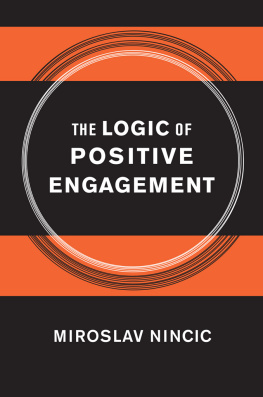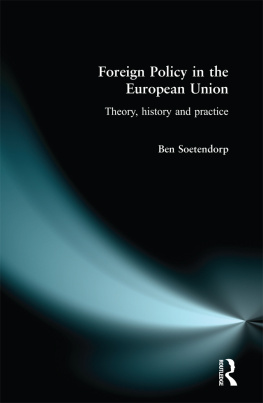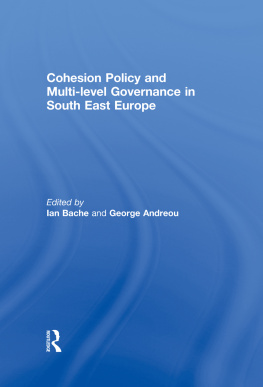THE LOGIC
OF POSITIVE
ENGAGEMENT
Miroslav Nincic
CORNELL UNIVERSITY PRESS ITHACA AND LONDON
Contents
Preface
The Failures of External Coercion
A Parallel Bias
A Framework for Analysis
Foundations of Success and Failure: Libya, Cuba, and Syria
The Challenge of North Korea and Iran
Final Thoughts
References
Preface
This book examines the promise and pitfalls of positive engagement (the use of diplomacy and material inducements) as a way of influencing the behavior of regimes considered threatening to the United States and the international community. My interest flows from the disappointing record of policies tilted toward threats and sanctions when dealing with such regimes. Military force, although sometimes suitable for undermining the capabilities of refractory adversaries, has (both in the form of threats and in the form of actual military intervention) an unimpressive record of altering policies. At the same time, most of the literature on economic sanctions judges such measures as rather ineffective.
The lackluster record of coercive and punitive policies notwithstanding, the assumptions behind such policies are rarely challenged by political scientists, who with some exceptions have invested little effort in examining alternatives. Academic indifference is all the harder to account for since other social sciences, especially sociology and social psychology, have exhibited roughly equal interest in rewards and punishments as paths to behavior modification. One of my tasks in this book is to account for why policymakers and political scientists are so loath to consider alternatives to generally ineffectual policies. Further, it offers a theoretical framework within which to study the possibilities for positive engagement, a framework that I apply to five instances of U.S. efforts to alter the policies of adversary regimes.
The failure of negative sanctions does not imply the necessary success of positive inducements, as the conditions for a favorable outcome in either case are restrictive. With respect to the latter, our starting point is a closer look at two purposes that positive incentives could serve. The first is to offer an adversary some concession intended to produce a desired counterconcession. The objective is a trade involving policy changes on the targets side; inducements offered in this spirit play out in the context of what I call the exchange model. Our task is to determine what objectives can most plausibly be attained in this fashion and what conditions bode best for success. The second aim of positive inducements is more ambitious: to change the other sides basic motivations so that bribes and punishments eventually become less necessary. The purpose is not so much to promote a trade as to catalyze a thorough overhaul of relations by altering the other sides policy priorities. Inducements offered with this purpose partake of what I call the catalytic model. I examine the logic behind the conceptions of positive inducements associated with these two models and the conditions for success or failure in both.
Success in the exchange model requires, above all, that inducements be of a magnitude sufficient to offset incentives to undesirable behavior on the targets part. I explain why it is often very difficult in the U.S. political context to offer concessions that are objectively sufficient, and I examine the circumstances within the target country that make it more or less receptive to an exchange of concessionsa condition of latent regime instability boding best for such receptivity.
With regard to the catalytic model, I explain how domestic change could be encouraged by modifying, from outside, the structure of politically relevant interests and preferences within the target state. I survey a few historical instances where such catalysis was a partial purpose of positive engagement, and I explain why regime instability, even more than in an exchange context, is a requirement for successful inducements with a catalytic intent.
I apply this theoretical framework to illuminate the conditions for the successful use of inducements in five countries whose policies have been considered especially objectionable by the United States.
In working on this book, I have benefited from the insights and comments of several scholars including Etel Solingen, Larry Berman, Arthur Stein, Donna Nincic, Robert Litwak, and an anonymous reviewer. I also acknowledge the valuable research assistance of Kali Rubaii.
THE FAILURES OF EXTERNAL COERCION
In this book I aim to improve our understanding of the methods by which foreign policy objectives may be pursued, especially those that involve core national interests. I focus, in particular, on the value of positive inducements directed at regimes regarded as adversaries by the United States and as renegades by significant parts of the international community. Positive inducements are not expressions of beneficence, nor are they instruments of soft power, meant to entice others to identify with ones policies by virtue of the moral authority one enjoys (Nye 2004). Positive inducements are tools of external leverage, designed to advance the nations interests, and a grasp of their promise and limitations implies a fuller understanding of the range of foreign policy options.
My interest stems from the disappointing record of a predominantly coercive U.S. approach to dealing with those nations whose interests and values clash with its own. It is deemed appropriate to deal with friends via rewards and engagement; by contrast, we expect to confront foreign adversaries with punitive pressures. When positive incentives, on occasion, do find their way into the mix of policies, they tend to be a weak adjunct to a core coercive thrust; and often they are resorted to both tepidly and late in the game, after the failures of established policy have been extensively absorbed.
The assumption in favor of negative pressures rarely is challenged from within the academic community, and international relations scholars have invested little effort in examining alternative policy strategies. (This academic indifference is hard to account for given that other social science disciplines, especially sociology and social psychology, have exhibited roughly equal interest in rewards and punishments as means of behavior modification.) This theoretical indifference is reflected in empirical research. Extensive datasets of military activities and economic sanctions are readily available, but one searches in vain for anything comparable with regard to rewards and incentives. A dominant lack of interest notwithstanding, isolated instances of positive inducements have occasionally appeared in a few interstices of scholarship.
The psychologists Thomas Milburn and Daniel Christie have observed, with respect to international rivalries, that in contrast to rewards, threats and punishments supply less information about what behavior is desired, lead to a narrower range of performance (involving less innovation between the parties), lead often to the appearance of older, earlier learned, more primitive behavior, and lead to more dislike of each party by the other, thus hindering the development of cooperation (Milburn and Christie 1989, 626). There has been a limited awareness that in interactive situations mutual cooperation can be encouraged by strategies of positive reinforcement. At the height of the cold war, Charles Osgood (1962, chap. 5) argued that such reinforcements would produce de-escalatory Soviet behavior, and he urged limited unilateral initiatives in that spirit. Robert Axelrod (1984) demonstrated that stable cooperation among adversaries linked by a shadow of the future is best promoted by a tit-for-tat strategy: noncooperative moves should evoke a response in kind, but so should cooperative gestures. In this vein, Alexander George has advocated combining rewards and punishments as a way of extracting concessions from outlaw states (George 1993, chap. 4).








